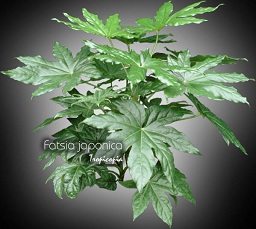Table of contents
Japanese Aralia

Latin Name: Fatsia japonica
Category: Aralia
Family: Araliaceae
Origin: Japan
Climate: Subtropical
Growing Zones: 11, 8
Care Instructions
The Japanese Aralia (Fatsia japonica) is a subtropical plant that originates from Japan. This aralia plant belongs to the Araliaceae family and is well-suited for growing in USDA zones 11, 8.
Complete Care Guide for Japanese Aralia (Fatsia japonica)
Watering Requirements
The Japanese Aralia, or Fatsia japonica, thrives in consistently moist soil but is sensitive to overwatering. It is essential to allow the top inch of soil to dry out between waterings. During the growing season, typically spring and summer, water the plant thoroughly, ensuring that excess water drains out of the pot. In the fall and winter months, reduce watering frequency as the plant enters a dormant phase. Always check the soil moisture with your finger; if it feels dry, it’s time to water. Be cautious of waterlogged conditions, as they can lead to root rot, a common issue for this species.
Light Conditions
Fatsia japonica prefers bright, indirect light but can tolerate low light conditions, making it an excellent choice for indoor spaces. Direct sunlight can scorch its leaves, so it’s best to place it near a window with filtered light or in a well-lit room. If grown outdoors, choose a location that receives partial shade, especially during the hottest parts of the day. While the plant can adapt to lower light levels, insufficient light may result in leggy growth and reduced leaf size. For optimal growth, aim for a balance of light that mimics its natural understory habitat.
Soil Preferences
The ideal soil for Japanese Aralia is a well-draining potting mix that retains some moisture without becoming soggy. A blend of peat moss, perlite, and compost works well, providing the necessary aeration and nutrients. The pH level should be slightly acidic to neutral, around 6.0 to 7.0. Regular fertilization during the growing season can enhance growth; use a balanced, water-soluble fertilizer every 4-6 weeks. In the fall and winter, reduce or eliminate fertilization as the plant’s growth slows down. Additionally, consider repotting every couple of years to refresh the soil and provide more space for root growth.
Pests and Diseases
Japanese Aralia is generally resilient but can be susceptible to common houseplant pests such as spider mites, aphids, and mealybugs. Regularly inspect the undersides of leaves and stems for signs of infestation. If you notice pests, treat them promptly with insecticidal soap or neem oil, ensuring thorough coverage of the affected areas. Fatsia japonica can also suffer from fungal diseases, particularly if overwatered. Signs of fungal issues include yellowing leaves and a mushy stem base. To prevent these problems, maintain proper watering practices and ensure good air circulation around the plant. If disease occurs, remove affected leaves and adjust care accordingly.
Special Care Tips
To keep your Japanese Aralia healthy and thriving, consider the following special care tips: First, regularly dust the leaves to enhance photosynthesis and prevent pests. Use a damp cloth to gently wipe the leaves, especially if the plant is indoors. Second, maintain humidity levels around the plant, as Fatsia japonica enjoys a humid environment. You can increase humidity by misting the leaves or placing a humidifier nearby. Third, prune the plant as needed to encourage bushier growth and remove any dead or yellowing leaves. Lastly, be mindful of temperature; Fatsia japonica prefers temperatures between 60°F and 75°F (15°C to 24°C) and should be protected from cold drafts and extreme heat. By following these care tips, you can enjoy the lush, tropical appearance of your Japanese Aralia for years to come.








